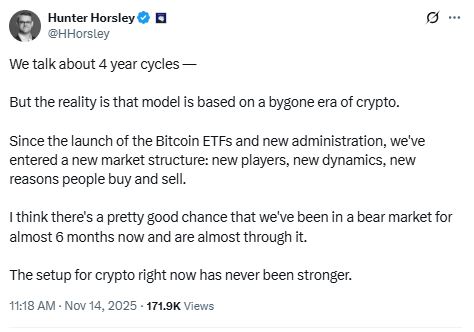Key Takeaways
- Bitwise CIO Matt Hougan claims the historic 4-year Bitcoin cycle is dead, replaced by a new regime of institutional demand and ETF flows.
- He argues that the halving’s impact has weakened, while interest-rate cycles are now favoring crypto.
- Rather than a volatile super-cycle, Hougan expects a steady, sustained boom into 2026.
- The rise of spot Bitcoin ETFs is a core part of this shift; they are reshaping cryptocurrency market structure in 2025.
- Despite recent market routs, long-term crypto fundamentals remain strong, underpinned by institutional adoption.
The crypto world is abuzz: is the bitcoin 4-year cycle dead in 2025? According to Matt Hougan, Chief Investment Officer at Bitwise, the familiar halving-driven rhythm might be giving way to an entirely new market regime. Let’s unpack what he means and how cryptocurrency market structure changes 2025 could reshape how we think about Bitcoin’s future.
What Bitwise’s CEO Is Arguing
Hougan argues that the once-predictable four-year cycle is no longer reliable. He believes three main forces made the old cycle fade:
- Weaker halving shock — Every halving matters less now, because its supply shock is diluted.
- More favorable interest-rate environment — Unlike prior cycles (2018, 2022), the current macro backdrop is positive for crypto.
- Growing institutional adoption — Inflows from institutions and Bitcoin ETFs are now a dominant force.
Hougan doesn’t see 2025 as the end of the road. Instead, he predicts a strong up-year in 2026, driven by fundamental demand rather than speculative froth. He calls it more of a “sustained, steady boom” than another super-cycle.

Why the Four-Year Halving Is Less Important Now
Traditionally, Bitcoin halvings (which occur roughly every four years) injected supply shocks that fueled price rallies. But according to Hougan, their market force is diminishing. Bitwise’s own capital market models back this up: each new halving reduces supply, but the magnitude of that impact shrinks.
In parallel, global macro conditions are changing. Instead of rate tightening triggering crash phases as in past cycles, current monetary policy may favor risk assets. Hougan suggests that the interest rate cycle is now “positive for crypto,” not a headwind.
The Role of Bitcoin ETFs & Institutional Capital
A major driver in this evolving market structure is the rise of spot Bitcoin ETFs. According to Hougan, these vehicles have fundamentally altered demand dynamics.
Where retail FOMO once dominated Bitcoin’s booms and busts, now financial institutions increasingly contribute significant long-term capital. The bitcoin ETF impact on market cycles is central to his thesis: ETFs provide a regulated, accessible mechanism for institutions to accumulate BTC over time, smoothing out volatility.
This shift may explain why Bitcoin’s volatility has dampened compared to prior cycles. Larger players — not just retail speculators — are now major participants.
A New Market Structure Emerging
From Hougan’s perspective, the cryptocurrency market structure changes in 2025 are historic:
- ETF flows are now a major pillar of demand, potentially more influential than halving cycles.
- Institutional adoption is not a flash in the pan but a sustained trend, likely to continue for years.
- Volatility could become more muted, as long-term capital absorbs shocks that used to spark mega drawdowns.
Because of that, Hougan envisions this as a multi-year run, not a short-lived speculative wave.
But What About the Market Rout?
Some skeptics point to recent crypto market sell-offs and suggest underlying risks. Yet, despite the volatility, many insiders believe fundamentals remain solid.
Market analysts argue that the recent crash may reflect short-term technical factors — leveraged trading, macro jitters — rather than a fundamental breakdown. Bitwise’s long-term models even highlight lower systemic blow-up risk now, thanks to stronger regulation and institutional infrastructure.
Alternative Views Still Exist
Not everyone agrees with Hougan’s thesis. For instance, Arthur Hayes, co-founder of BitMEX, also declared the four-year cycle dead. He argues that global monetary policy — not halving timing — now drives Bitcoin’s moves. Hayes points out that past cycles ended when liquidity tightened, not merely due to halving.
Meanwhile, some venture capitalists remain cautious. One predicted a potential 70% drawdown in a future downturn, suggesting that cycle patterns may not be fully broken.
Read Also: Strategy Accelerates BTC Plan After Rumor Storm
Disclaimer!! The information provided by CryptopianNews is for educational and informational purposes only. It should not be considered financial or investment advice. Cryptocurrency markets are highly volatile and speculative, and investing in them carries inherent risks. Readers are advised to conduct their own research and consult with a qualified financial advisor before making any investment decisions.
- Unpacking the Forces Driving the 2025 Crypto Rally - November 16, 2025
- Are 4-Year Bitcoin Market Cycles Dead? Bitwise CEO Explains New Market Structure - November 15, 2025
- Bitcoin Bubble Analysis: Understanding the Diaman Ratio Indicator - November 13, 2025

